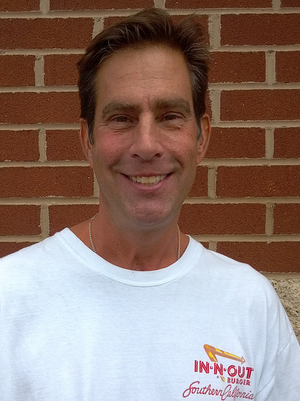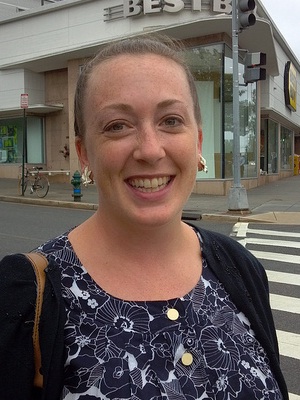By Mary-Alice Farina
Before the transformation of the Anacostia Waterfront and the Navy Yard began, there was Foggy Bottom. The fashionable Northwest neighborhood, now home to luxury condominiums, pristine river views and affluent seniors, was characterized by tenement dwellings, smoke stacks and slums 60 years ago.
At the end of the 18th century, the riverbanks now dominated by the Kennedy Center were D.C.’s gang-ridden and malaria-infested industrial hub. Breweries, lime kilns, shipyards and the Washington Gas Light Company facility brought an influx of European immigrants to Foggy Bottom. Foggy Bottom residents, mostly unskilled manual laborers, often spoke no English.
Prev
Next
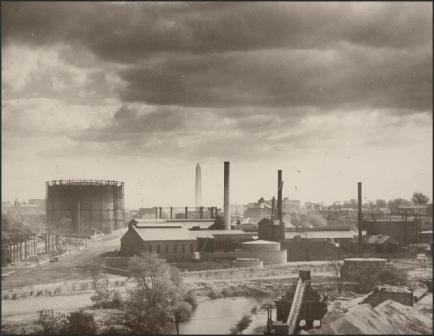
Virginia Avenue skyline with the tanks and smokestacks of the Washington Gas Company, circa 1928.

The Kennedy Center overlooks the Potomac River. Its riverbanks were once D.C.'s malaria-infested industrial hub.
Looking south down 23rd and I streets circa 1938.
Historic photo courtesy of GWU/Mary-Alice Farina permalink
On left: Roof of the Hattie M. Strong Residence Hall for Women circa 1943. On right: The Washington Monument from two Foggy Bottom rooftops.
Erection of Clark Mills statue of George Washington on Washington Circle, Feb. 22, 1860
Eldra Walker/ Mary-Alice Farina permalink
Pictured left: Snow's Court alley dwellings, circa 1935. Pictured right: Snows Court today.
Snow's Court today.
Historic photo courtesy of GWU permalink
Quigley's Pharmacy at 21st and G Streets, circa 1910, and in 2011.
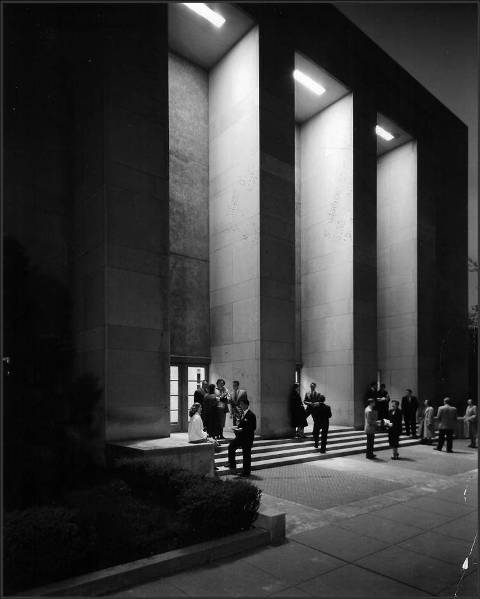
The Lisner Auditorium on the campus of George Washington University was the Kennedy Center of its time.
The area around Washington Circle, named “Round Tops” after the notorious gang that controlled it, was considered one of the most dangerous parts of town. During the population boom after the Civil War, Foggy Bottom’s “ethnic” and working class inhabitants were primarily Irish and German. A Washington Post article quoted a then-resident: “If you picked a fight with an Irishman at 17th Street, you’d have to fight every other Irishman down to the river at 27th Street before you could escape.”
Continue reading →
Prev
Next
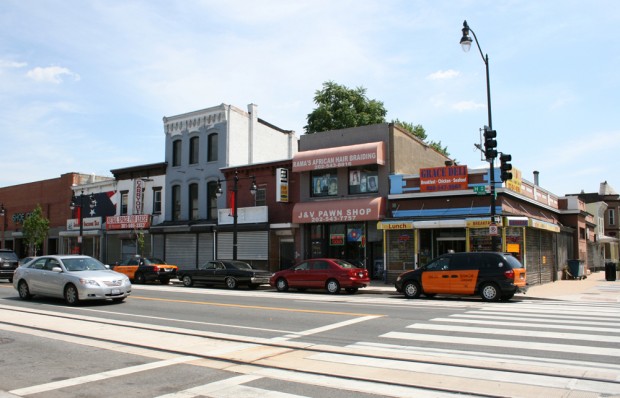
Elahe Izadi / DCentric permalink
The corner of 7th and H streets NE has a mix of small, longtime businesses and vacancies.
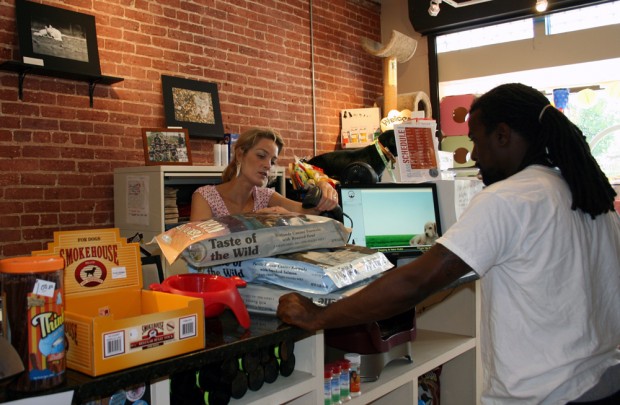
Elahe Izadi / DCentric permalink
Anna Collins, co-owner of Metro Mutts at 5th and H streets NE, rings up a customer.
Elahe Izadi / DCentric permalink
Metro Mutts is located at 5th and H Street, NE, on the same block as several small business and some vacancies.
Elahe Izadi / DCentric permalink
Terri Hill, manager of A Fresh Look by Janice & Company at 7th and H streets NE.
Elahe Izadi / DCentric permalink
Michelle Jones, owner of A.S.P.I.R.E. health store at 7th and H streets NE.
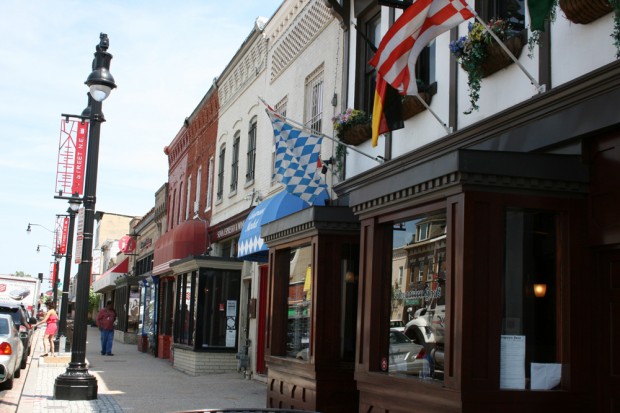
Elahe Izadi / DCentric permalink
A number of new businesses have populated formerly vacant storefronts along the upper end of H Street. But they're mostly restaurants and bars.
Much has been made of the changes along H Street NE as the corridor continues its transformation from a primarily low and middle income black community to one that is wealthier and whiter. Trendy bars and restaurants are increasingly opening in vacant storefronts, attracting diverse patrons en masse during late night hours. But the crowds are nowhere to be seen during the day.
A new D.C. grant program is intended to draw more retail options to the street, creating an H Street that’s as bustling during the day as during the evening. That’s welcome news for many existing business owners who want more people on the streets and in their shops.
“You just don’t want it to be all bars and restaurants,” said Anna Collins, co-owner of pet store Metro Mutts at 5th and H streets.
Continue reading →
Prev
Next

Elahe Izadi / DCentric permalink
Del. Eleanor Holmes Norton hosted a D.C.-wide job fair Tuesday.
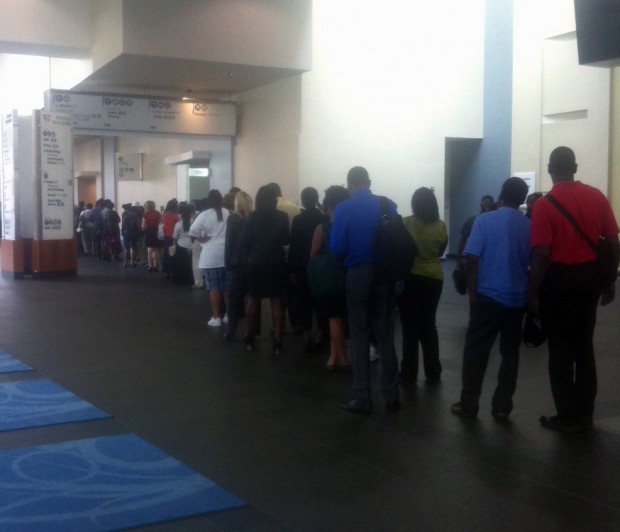
Elahe Izadi / DCentric permalink
Job seekers formed a line that wrapped throughout the Convention Center for a D.C. job fair Tuesday.
Elahe Izadi / DCentric permalink
Job seekers came armed with resumes to Tuesday's District job fair. But employers directed people to apply online rather than in person.
Elahe Izadi / DCentric permalink
Job seekers found any available space to fill out job applications at Tuesday's job fair.
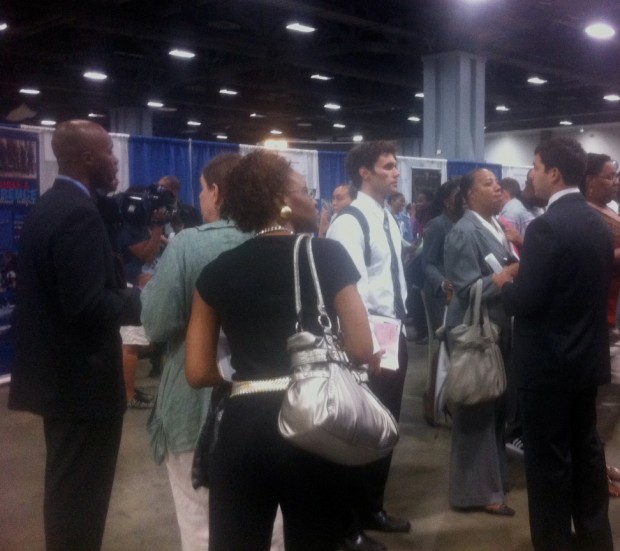
Elahe Izadi / DCentric permalink
About 4,100 unemployed and underemployed District residents came to Tuesday's job fair.
An annual D.C. employment fair drew one of its biggest crowds Tuesday as the District faces an unemployment rate that is higher than the national average.
“This turnout breaks my heart,” said Del. Eleanor Holmes Norton, who hosted the 14th annual fair. “This is a record I wasn’t out to break.”
Last year, about 3,500 people attended Norton’s fair. This year, nearly 4,100 District residents came. About 500 people waited for doors to open at 11 a.m. By noon, a large line of job seekers weaved throughout the Convention Center, from the entrance, down escalators and wrapped around long hallways.
Unemployment in the District is uneven; jobless rates are higher than 20 percent in predominately black and low-income Ward 8, while it’s slight above 3 percent in affluent Ward 3 [PDF].
“The disparity has to be gotten rid of in the District,” Norton said. “The only good jobs available in the government or private sector are upscale jobs. If you don’t have at least a year or two of college, you’re doomed.”
Continue reading →
Hungarians preparing Japanese dishes; Koreans serving Eastern European fare; Salvadorans making kabobs –a number of D.C. chefs and restaurant owners serve cuisine from countries far from their motherlands. Some to great acclaim.
But is the food authentic? Does it even matter?
“There are two kinds of music: Good music, and the other kind.” – Duke Ellington
Washingtonian food critic Todd Kliman answers with a Duke Ellington quote: “There are two kinds of music: good music, and the other kind.”
“Is it desirable [for food] to be authentic? It depends on who you ask,” Kliman says. “Some people say ‘Yes.’ Others say, ‘It doesn’t matter as long as the food is delicious.’”
Continue reading →
This week, we recommend attending the Saturday opening of “Race: Are We So Different?” at the Smithsonian’s Natural History Museum.
We got a sneak peak of the exhibition this week and took some photos, which you can see below. A long room in the museum is devoted to exploring the scientific, historical and and societal assumptions and theories around race. The exhibition aims to educate and challenge assumptions around race, but also solicits attendees to contribute their thoughts on their own experiences. If you’re looking for a good way to start an in-depth discussion about race, you can find it here.
The nationally touring exhibition, part of an American Anthropological Association project, is free to view and will be on display until Jan. 2, 2012. A number of talks and other events are scheduled throughout its time at the museum, so check the calendar for more information.
Prev
Next
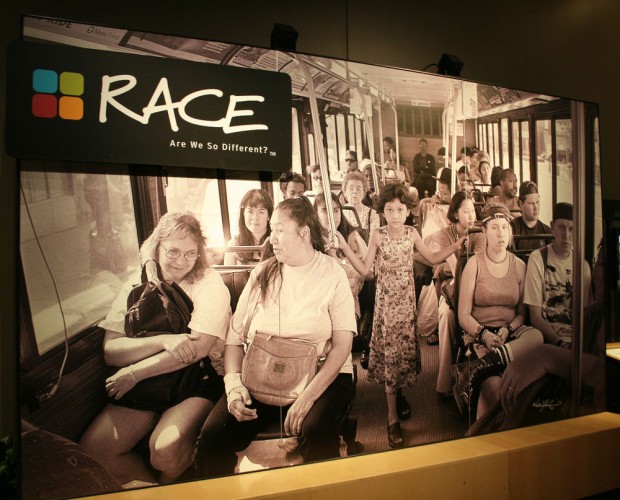
"Race: Are We So Different?" will be open on view in the Smithsonian's Natural History Museum until January 2012.
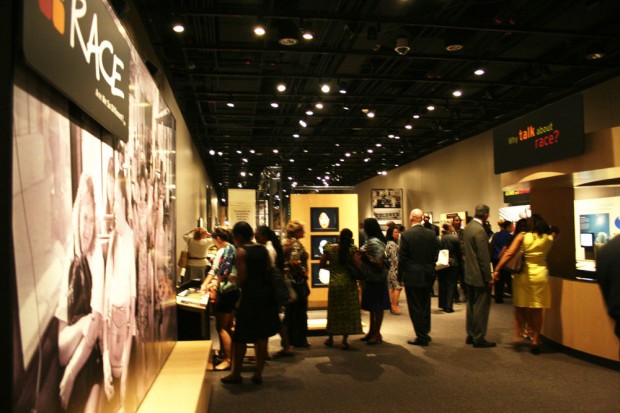
The exhibition starts with asking attendees to discuss why race is important, and then proceeds to break down assumptions, antiquated scientific theories and the history of race in the U.S.
The exhibit starts with emphasizing our common ancestry. A giant map demonstrates that all of humanity's roots trace back to Africa.
Seemingly simple questions -- "How are we alike and different?"-- with interactive elements give attendees pause
Interactive elements are incorporated throughout the exhibition. Here, a woman learns about the ancestry of people of varying races.
Discrimination is not always based on appearances -- voice can play a factor, too. Various portions of the exhibition use data to demonstrate how racism plays out in various aspects of life and society.
The exhibition not only examines race today in the U.S., but the history of race as well, including segregation in the U.S. and how the concept of race was formed around power.
Stacks of money represent the average net worth of families, divided by race. The data is based on U.S. Census Bureau statistics. The pile on the front left represents an Asian family's net worth and the pile on the front right represents a black family's net worth. The pile in the back left represents a white family's net worth, and to the right, a Latino family's net worth.
A billboard portrays the pitfalls of using Native American imagery as sports team mascots, something that has unique relevance for D.C.
Privilege is linked to race, as this road sign demonstrates. Also, the newspaper box is actually a television!
Art is incorporated into the exhibition. A series of portraits hang on one wall, captured by a photographer who asked participants to identify themselves. The artist was struck by the complexity of identity for those with partial Asian Pacific Islander ancestry.
The concept of "whiteness" was developed over time as well. European immigrants were once seen as "ethnic." Now, their ancestors are considered "white."
New Census forms debuted in 2010 that asked more detailed questions about race. But is this really the best method to determine the racial makeup of our country? Participants can cast their votes on the question.
The exhibition includes room for roundtable discussions and lockers curated by students from D.C.'s School Without Walls. The students were asked to design lockers to answer questions such as "What is race?" and "Has your life been affected by race?"
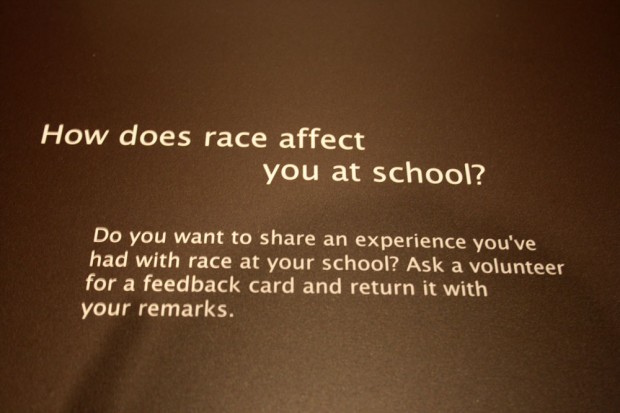
This sign is displayed at a table nearing the end. It provides an excellent prompt for young people to have discussions about race, particularly in light of everything else they just saw in the exhibition.
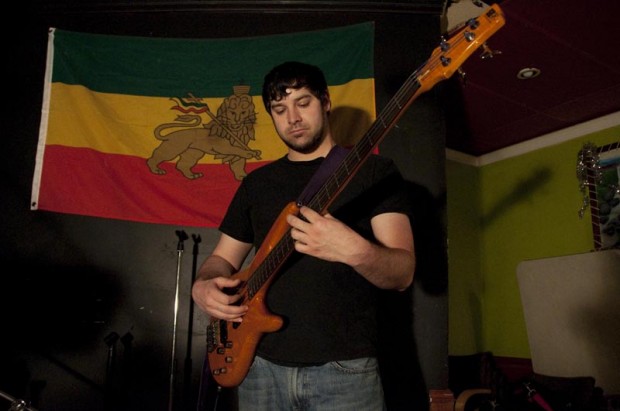
Courtesy of Bora Chung
Brian Waitzman plays with pop-Americana singer Flo Anito at Almaz on Sunday. An Ethiopian flag hangs behind him.
On Sunday afternoon, Ethiopian music blared from speakers in the first floor dining room of 1920, a Habesha restaurant in the heart of Little Ethiopia. But the sound of a woman crooning in Amharic was overpowered by Bake Sale, a post-pop rock band playing on the second floor.
All up and down the U Street Corridor this past weekend, bands representing an eclectic range of rock music played in Ethiopian and Eritrean restaurants as part of the first Sweet Tea Pumpkin Pie Music Festival. Six Habesha-owned or themed restaurants took part.
Organizer Dave Mann said when he first hatched the idea to hold a two-day rock music festival, he asked the city’s more traditional rock venues to host shows, “but they weren’t into it.” Some already had booked calendars and this was the first STPP festival, so it was uncertain how much revenue it’d bring in.
Then Mann met Mike Naizghi, the Eritrean owner of Bella Café, who was looking for music to fill the second-floor of his café that serves American and Eritrean fare. He then introduced Mann to more Little Ethiopia restaurant owners, and soon six were on board. The restaurants made money through drink and food sales, the bands made money through merchandise sales and all shows were free. Mann brought more than 100 bands to the restaurants and he plans to hold a bigger festival in October.
“The consensus of all of the owners of the Ethiopian restaurants is, they say to me, ‘Look, there are tons of Ethiopian places in D.C., so obviously a lot of them aren’t going to have the same amount of business as the others. We need a different clientele,’” Mann said.
Continue reading →
The Mount Pleasant riots began on May 5, 1991 after a police officer shot a Salvadoran immigrant. Last week’s Metro Connection took a look at what happened during those two tumultuous days, and today’s Kojo Nnamdi show featured a discussion around the legacy of the riots for D.C.’s Latino community.
The riots, which also spilled over into Columbia Heights, left a lasting mark a neighborhood that has changed dramatically in the past 20 years. We take a look at Mount Pleasant today:
Prev
Next
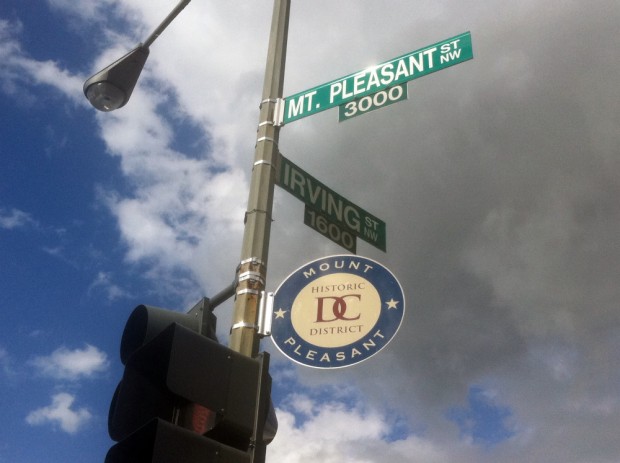
Mount Pleasant was the epicenter of riots that began on May 5, 1991, in response to a police shooting of a Latino man. The neighborhood is now a quaint enclave in Northwest.
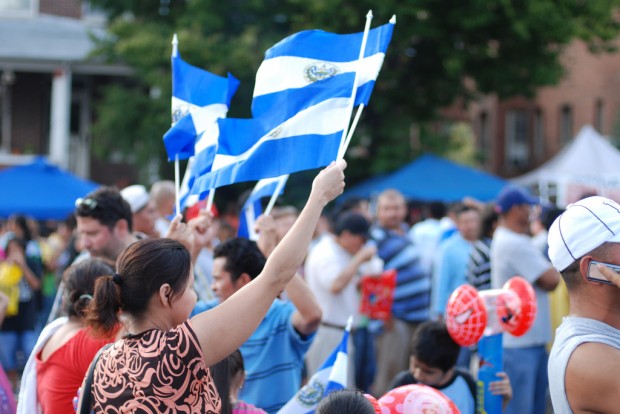
Flickr: Cameron Nordholm permalink
An influx of immigrants fleeing El Salvador’s civil war in the 1980s and 1990s settled in Mount Pleasant and Columbia Heights. Here, a woman shows her Salvadoran pride during the 2008 Fiesta DC festival in Mount Pleasant.
Jose Quevas, owner of Distribuidora El Salvador Del Mundo, has been on Mount Pleasant Street for 23 years. He said there are more businesses on the street than two decades ago, “and now with the Metro, it brings more people here.”
Flickr: M.V. Jantzen permalink
The Columbia Heights Metro Station opened in 1999, which helped change the landscape of the entire area. Big retailers and luxury apartment complexes soon followed.
Walter Martinez has been living in Mount Pleasant for more than 35 years. He’s seen the neighborhood change from predominately black to being mostly Latino in the 1990s. He said the Metro station and Columbia Heights development helped spur an influx of white residents. “That’s how this got to be a more expensive place to live. Before, our apartment, a 2-bedroom, was $300 [a month]. Now, it’s $1,300.”
DC USA opened in 2008 in nearby Columbia Heights. National retailers filled the mall, including Target, Best Buy and Marshalls.
Mount Pleasant Street now has a mix of new and older businesses.
Alex Kramer opened Dos Gringos on Mount Pleasant Street 10 years ago. She named her restaurant as a nod to the fact that she and her then-business partner were opening up in a predominately Latino neighborhood “I didn’t want to come into a neighborhood and change it," she says. Kramer works with fellow business owners and helps organize a language exchange in the neighborhood. “The customers, it’s definitely a mix. On Saturdays and Sundays, it’s more of the newer people in the neighborhood. But during the workweek, we sell $1 cups of coffee outside” which attracts a variety of customers, she says.
A woman sells tropical fruits at this produce stand that’s been in Mount Pleasant since 1994. Owner Ignacio Nunez (not pictured) says back then “there was a lot of disorder. When we would get here in the morning, they’d say, ‘last night someone was shot on that corner.’ Not anymore.”
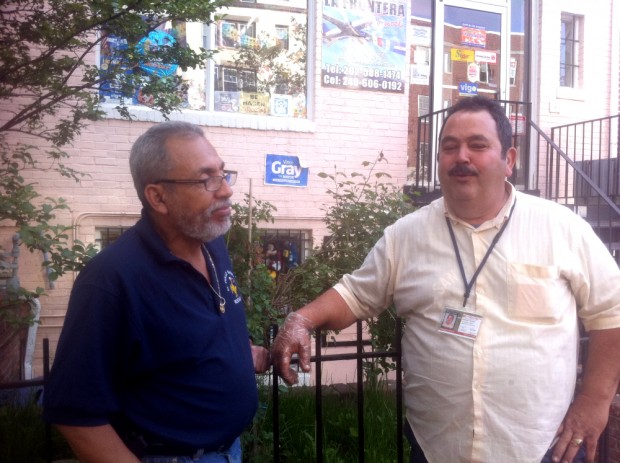
Ignacio Nunez (right) talks with Walter Martinez (left) about the changes the neighborhood has seen in the past couple of decades. Nunez says there are still a lot of Latinos in the neighborhood. “But before, nobody wanted to live here, the only ones who lived here had to. Now, everyone in the world wants to live here.”




